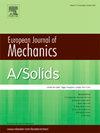Extracting mechanical properties and uniaxial stress-strain relation of materials from dual conical indentation by machine learning
IF 4.4
2区 工程技术
Q1 MECHANICS
引用次数: 0
Abstract
Indentation testing is one of the most convenient methods to investigate the mechanical response of materials because of its comparative simplicity in sample preparation and capabilities in testing specimens with small-volumes where tensile experiments are difficult to perform. For indentation problems, it is attractive and meaningful to directly determine the elasto-plastic properties (parameters) or tensile stress-strain relations of materials from indentation responses. In this work, an artificial neural network (ANN) model is combined with finite element (FE) analysis to address this inverse indentation problem. To avoid the non-uniqueness issue, both indentation load-depth curves of two commonly used sharp indenters, namely conical and Berkovich indenters, are employed to inversely identify the material properties. A database generated by FE simulations is used to train the ANN model. The prediction performance of the trained ANN model was validated by testing the model on the simulated and experimental load-depth data. The results indicate that the ANN model can accurately predict the material parameters from only the loading part of indentation load-depth curves. In addition, the relationship between the prediction accuracy and the values of material parameters, the comparison between the prediction performances of ANN models based on single and dual conical indentation, and the effect of data noise on the prediction accuracy of the ANN model, are systematically discussed. The ANN-based method of inverse indentation analysis proposed in this study provides a convenient and effective alternative method for predicting material properties from indentation tests.

求助全文
约1分钟内获得全文
求助全文
来源期刊
CiteScore
7.00
自引率
7.30%
发文量
275
审稿时长
48 days
期刊介绍:
The European Journal of Mechanics endash; A/Solids continues to publish articles in English in all areas of Solid Mechanics from the physical and mathematical basis to materials engineering, technological applications and methods of modern computational mechanics, both pure and applied research.

 求助内容:
求助内容: 应助结果提醒方式:
应助结果提醒方式:


